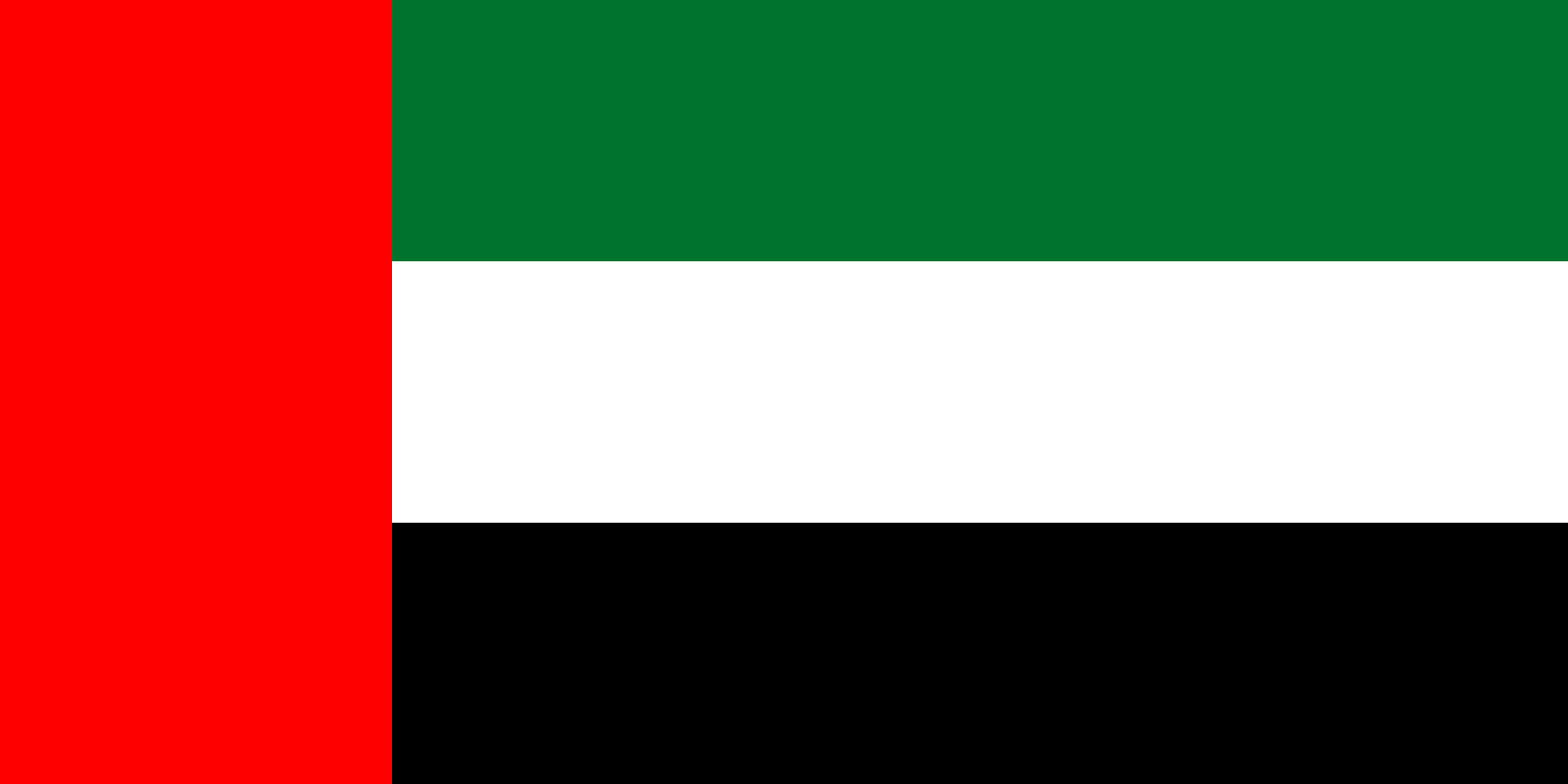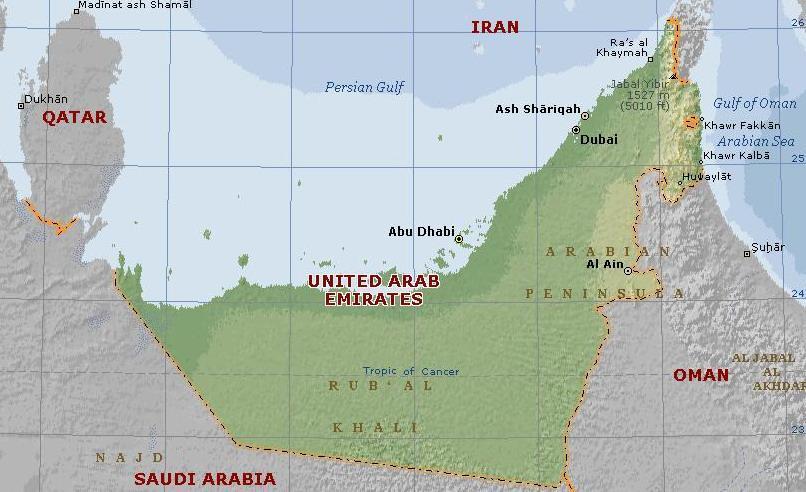


The United Arab Emirates (UAE) is a federation of seven emirates: Abu Dhabi, Dubai, Shariqah, Ras Al Khaymah, Fujayrah, Umm Al Qaywayn and Ajman. By far the largest emirate in Abu Dhabi and Abu Dhabi City is the capital of both the emirate and the whole country. The UAE is situated in the eastern corner of the Arabian Peninsula and is bordered in the north by the Persian Gulf, in the east by the Gulf of Oman and Oman and in the south and west by Saudi Arabia. Six of the seven emirates lie on the coast of the Persian Gulf, while the seventh, Fujayrah, is situated on the eastern coast of the peninsula and has direct access to the Gulf of Oman.
The total area of the UAE is about 83 600 km2 (Table 1), of which 77 700 km2 is the mainland surface area, where the population lives. Abu Dhabi Emirate represents almost 87 percent of the mainland area (Table 2). The coast stretches over a shallow marine area, with many islands and coral reefs. The total area of the many – and generally uninhabited – islands is about 5 900 km2. The UAE can be divided into three ecological areas: the northeastern mountain areas, sandy/desert areas and marine coastal areas; 80 percent of the area of the UAE is desert, especially the western area.
United Arab Emirates Population 2020
| 10,068,598 | Current population |
| 6,994,480 | Current male population (69.5%) |
| 3,074,118 | Current female population (30.5%) |
| Species | Admin unit | Population | Units | Number of establishments | Units |
|---|---|---|---|---|---|
| Birds | The Whole Country | 49257221 | Animals | 43 | Establishments |
| Camelidae | The Whole Country | 474268 | Animals | Establishments | |
| Cattle | The Whole Country | 86423 | Animals | 17 | Establishments |
| Cervidae | The Whole Country | 2560 | Animals | 60 | Establishments |
| Equidae | The Whole Country | 28000 | Animals | Establishments | |
| Goats | The Whole Country | 1978437 | Animals | Establishments | |
| Rabbits | The Whole Country | 2100 | Animals | 80 | Establishments |
| Sheep
|
The Whole Country
|
2016777
|
Animals
|
|
Establishments
|
Agriculture
Agriculture in the United Arab Emirates, including fishing, was a minor part of the UAE economy in the early 1990s, contributing less than 4 percent of GDP.[1] Since the formation of the UAE, the availability of capital and the demand for fish production has encouraged agricultural development. The main farming areas are Diqdaqah in Ras al-Khaimah. Falaj al Mualla in Umm al Qawain, Wadi adh Dhayd in Sharjah, Al Awir in Dubai and the coastal area of Al Fujairah. Total cultivable land is around 160,000 hectares.
The main farming areas are Diqdaqah in Ras al-Khaimah.Falaj al Mualla in Umm al Qawain, Wadi adh Dhayd in Sharjah, Al Awir in Dubai and the coastal area of Al Fujairah. Total cultivable land is around 160,000 hectares.
Lack of arable land, intense heat, periodic locust swarms, and limited water supplies are the main obstacles to agriculture. The drive to increase the area under cultivation has resulted in the rapid depletion of underground aquifers, resulting in precipitous drops in water tables and serious increases in soil and water salinity in some areas. As a result, several farms have been forced to cease production. Despite the creation in 1983 of a federal authority to control drilling for water, development pressures in the 1980s and 1990s increased the exploitation of underground water supplies.
Poultry farms provided 70 percent of local requirements for eggs and 45 percent of poultry meat needed in 1989. Local dairies produced more than 73,000 tons of milk in 1991, meeting 92 percent of domestic demand.
Considerable revenues have been devoted to forestation, public landscaping, and parks. Trees and shrubs are distributed free to schools, government offices, and residents. Afforestation companies receive contracts to plant plots in the range of 200 to 300 hectares. The goals are to improve the appearance of public places as well as to prevent the desertification process in vulnerable agricultural areas.
Livestock
Livestock production has risen sharply in recent years. In 2001, the UAE had 1,300,000 goats, 550,000 sheep, 220,000 camels, and 97,000 head of cattle. Dairy farming is centered in Ras al-Khaimah, with other dairy farms in Al Ain, Umm Al Quwain, Sharjah, and Dubai. The UAE produces about 90% of its daily needs. Local poultry and egg production satisfy 27% and 40% of domestic demand, respectively. Five major producers account for 75% of the domestic chicken production. The poultry farm at Fujairah can supply over 15% of domestic demand for broilers and eggs. Ras al-Khaimah and Al Ain are other centers of poultry production. Production of poultry meat reached 37,000 tons in 2001, with imports of poultry meat (mainly from France, Denmark, the United States, and Brazil). The UAE also re-exports poultry meat, mostly to Oman, former Soviet republics, and Iran.
Climate
Climate is arid with very high summer temperatures. The coastal area, where the bulk of the population lives, has a hot and humid climate in the summer with temperatures and relative humidity reaching 46°C and 100 percent respectively. Winters are generally mild with temperatures between 14°C and 23°C. The interior desert region has hot summers with temperatures rising to about 50°C and cool winters during which the lowest temperature can fall to around 4°C.
Mean annual rainfall is about 78 mm, ranging from less than 40 mm around Liwa in the southern desert to 160 mm in the northeastern mountains. Precipitations cover a period of between 9 and 19 days over the whole year. Over 80 percent of the annual rainfall occurs during the winter (December to March). In spring (April–May) rainfall is infrequent and is usually associated with isolated thunderstorms. In summer (June–September), rain is rare and occurs as a result of the afternoon thunderstorm over the eastern highlands or isolated thunderstorms accompanying the rarely occurring sea breeze fronts. On a very few occasions, the Inter-Tropical Convergence Zone (ITCZ) may move northwards and give some rainfall over the area. The most settled weather conditions with very little rain prevail in the autumn (October–November), especially in October.
United Arab Emirates Delegate
Dr. Majid Al Qassimi
Member of the WOAH Council
Director
Animal Health and Development Department
Ministry of Environment and Climate Change
PO BOX 1509
Dubai
UNITED ARAB EMIRATES

